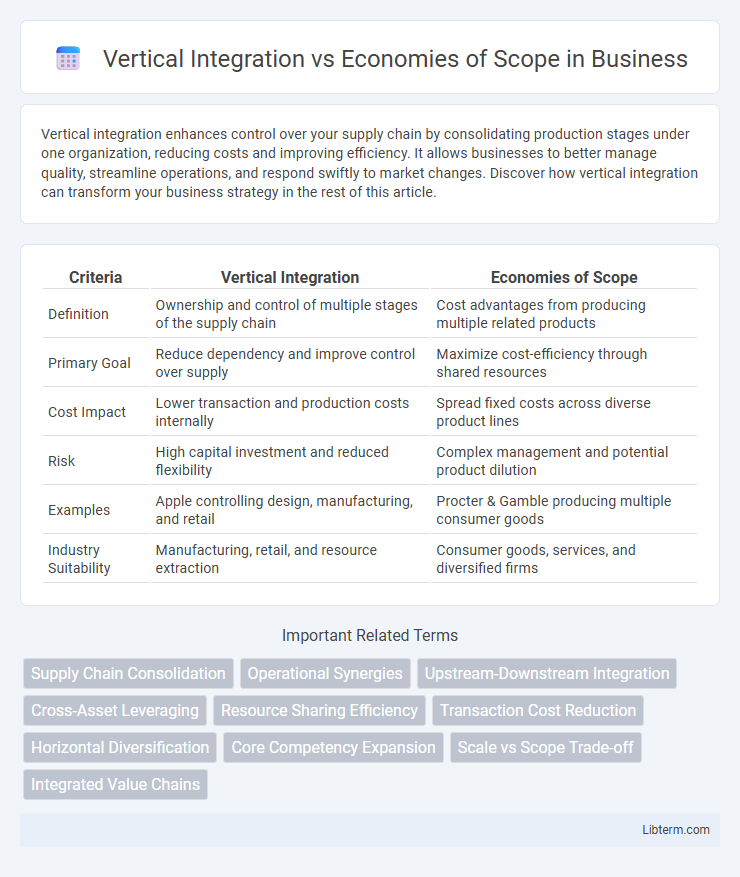Vertical integration enhances control over your supply chain by consolidating production stages under one organization, reducing costs and improving efficiency. It allows businesses to better manage quality, streamline operations, and respond swiftly to market changes. Discover how vertical integration can transform your business strategy in the rest of this article.
Table of Comparison
| Criteria | Vertical Integration | Economies of Scope |
|---|---|---|
| Definition | Ownership and control of multiple stages of the supply chain | Cost advantages from producing multiple related products |
| Primary Goal | Reduce dependency and improve control over supply | Maximize cost-efficiency through shared resources |
| Cost Impact | Lower transaction and production costs internally | Spread fixed costs across diverse product lines |
| Risk | High capital investment and reduced flexibility | Complex management and potential product dilution |
| Examples | Apple controlling design, manufacturing, and retail | Procter & Gamble producing multiple consumer goods |
| Industry Suitability | Manufacturing, retail, and resource extraction | Consumer goods, services, and diversified firms |
Introduction to Vertical Integration and Economies of Scope
Vertical integration involves a company expanding its operations into different stages of production within the same industry to increase control and reduce costs. Economies of scope occur when a firm efficiently produces a variety of products, leveraging shared resources and capabilities to lower overall costs. Both strategies aim to enhance competitive advantage but differ in their approach to growth and operational efficiency.
Defining Vertical Integration: Key Concepts
Vertical integration refers to a company's ownership and control over multiple stages of its production process, from raw materials to final product delivery, enhancing operational efficiency and reducing reliance on suppliers. This strategic approach integrates upstream suppliers and downstream distributors, streamlining supply chains and fostering tighter coordination. Key concepts include backward integration, securing inputs, and forward integration, optimizing distribution channels to achieve cost savings and competitive advantage.
Understanding Economies of Scope: Core Principles
Economies of scope arise when a company efficiently produces a variety of related products or services using shared resources, reducing overall costs compared to producing each product separately. This concept relies on the strategic leverage of operational synergies, such as shared technology, distribution channels, and marketing efforts, to optimize resource utilization. Understanding economies of scope involves recognizing how diversifying product lines within the same firm can create competitive advantages through cost savings and improved market responsiveness.
Differences Between Vertical Integration and Economies of Scope
Vertical integration involves a company controlling multiple stages of the production or supply chain to reduce costs and increase efficiency, while economies of scope achieve cost advantages by producing a variety of related products together. Vertical integration emphasizes ownership and control over upstream or downstream processes, whereas economies of scope focus on leveraging shared resources and capabilities across different product lines. The key difference lies in vertical integration's concentration on supply chain coordination versus economies of scope's emphasis on diversified production to lower average costs.
Strategic Benefits of Vertical Integration
Vertical integration enhances control over the supply chain, reducing dependency on external suppliers and improving operational efficiency. It allows firms to capture upstream and downstream profit margins, fostering cost savings and improving market responsiveness. Strategic benefits include stronger competitive positioning, improved product quality, and increased barriers to entry for competitors.
Competitive Advantages of Economies of Scope
Economies of scope provide competitive advantages by enabling firms to reduce costs through the efficient sharing of resources and capabilities across multiple products or services, enhancing operational flexibility and innovation. Unlike vertical integration, which focuses on controlling the supply chain, economies of scope leverage diversified product offerings to attract a broader customer base and create synergistic value. This strategic advantage fosters market differentiation and resilience by optimizing resource utilization and expanding market presence simultaneously.
Industry Examples: Vertical Integration vs. Economies of Scope
Vertical integration is exemplified by companies like Apple, which controls design, manufacturing, and retail to enhance quality and reduce costs. Economies of scope appear in conglomerates such as Virgin Group, leveraging diverse business units like airlines, media, and telecommunications to share resources and capabilities. These strategies highlight different approaches: vertical integration deepens control over the supply chain, while economies of scope broaden the range of products and services.
Risks and Challenges in Implementing Vertical Integration
Implementing vertical integration poses significant risks such as increased capital investment, reduced flexibility, and potential supply chain disruptions. Companies may face challenges in managing diverse operations, leading to inefficiencies and higher operational costs. Furthermore, vertical integration can result in antitrust issues and decreased responsiveness to market changes, impacting overall competitive advantage.
Limitations and Drawbacks of Economies of Scope
Economies of scope face limitations such as increased management complexity and potential inefficiencies when diversifying product lines beyond a firm's core competencies. The risk of resource dilution can reduce overall productivity and lead to higher operational costs, outweighing the benefits of shared capabilities. Firms may also encounter coordination challenges and diminished focus, which can hinder innovation and market responsiveness.
Choosing the Right Strategy: Factors to Consider
Choosing the right strategy between vertical integration and economies of scope depends on factors such as the firm's core competencies, market control, and cost structure. Vertical integration suits companies seeking greater control over their supply chain and reducing transaction costs, while economies of scope benefit firms aiming to leverage shared resources across diverse but related product lines to achieve cost efficiency. Evaluating industry dynamics, resource capabilities, and potential risks is essential to determine which approach maximizes competitive advantage and profitability.
Vertical Integration Infographic

 libterm.com
libterm.com